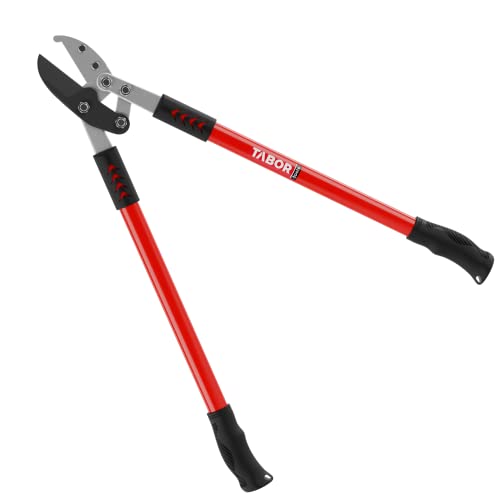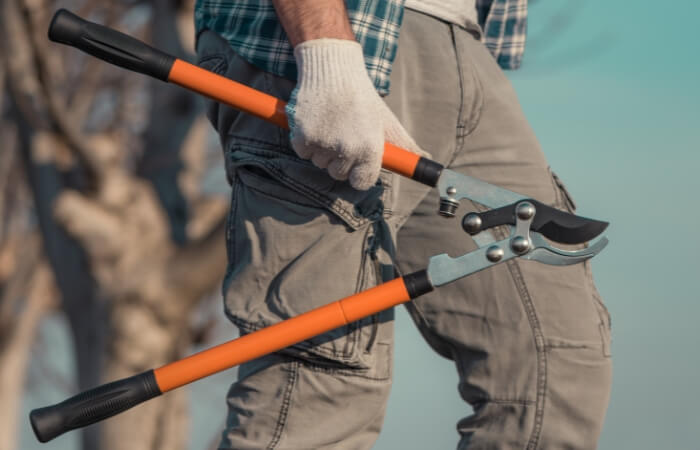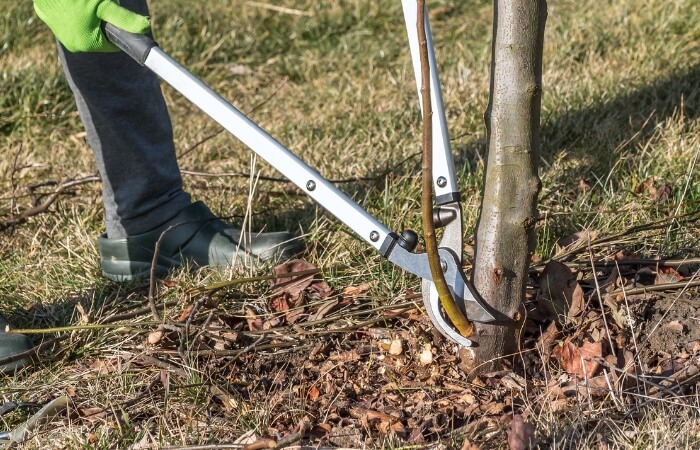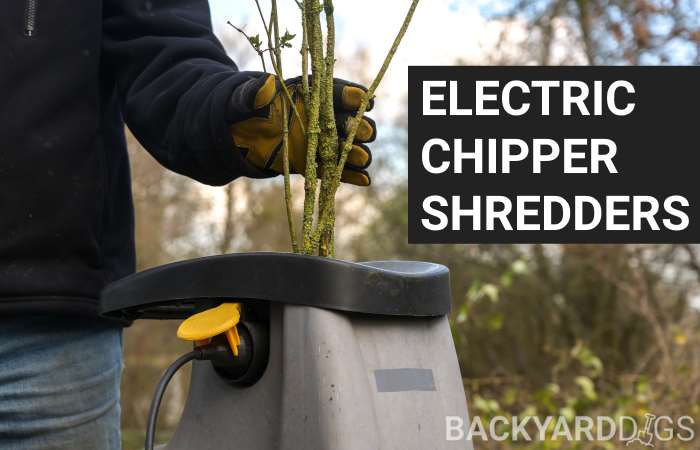Curb appeal starts with manicured landscaping, and the best way to achieve that is with garden loppers.
Loppers keep your bushes and trees trimmed to perfection with less stress than cutting through branches using small pruners, pruning saw, or pulling out a noisy, bulky chainsaw.

This buying guide reviews the 5 best lopper models, explains why you need loppers, detail important features, and answer common questions.
By the end, you’ll be ready to select the ideal loppers to keep your landscaping looking impressive!
A quality pair of loppers deserve a spot in your garden shed, so you are always ready for those mid-range pruning tasks that can sneak up on you in a hurry.
What I Look For:
| Blades | Made Of High-Quality Steel |
| Cutting | Cuts Up To 1″ Branches |
| Usage | Needs To Be Comfortable |
Top 5 Best Loppers
Best Overall For Large Branches
Fiskars Ratchet Drive Anvil Lopper

Reasons To Buy
- Hardened-steel blades are precision ground for a sharp edge that cuts cleanly
- Anvil cutting becomes more robust with the addition of the ratchet mechanism
- DuraFrame handles with integrated grooves for gripping connect to a steel exoskeleton that won’t flex during use
- 27-inch length can access harder-to-reach branches
Reasons To Avoid
- Need a wide arm span to open the tool fully
- Some issues with blades snapping off during use
The Fiskars Ratchet Drive Anvil Lopper features a ratchet mechanism that brings the most force with the least amount of effort on every squeeze so that you can finish up your pruning chores fast.
I like the sharp, hardened-steel blades that work in tandem with the ratchet cutting style, so even thick branches up to 2-inches in diameter require less arm strain. The low-friction coating on the blade means even smoother cuts along with reducing the chance of rust.
On the downside, you need to really open the handles wide on this tool to get it set on thicker branches, which can be challenging for people with shorter arms.
The Fiskars Ratchet Drive Anvil Lopper is the top contender for the toughness of build and the ratchet-style cutting. This is an ideal garden tool for homeowners needing to prune thicker branches.
Best For Light Pruning And Small Tasks
GRÜNTEK Anvil Pruning Loppers

Reasons To Buy
- High-quality carbon-steel blade features a non-stick coating, so it cuts with precision and can be sharpened as necessary
- Gear-drive mechanism increases leverage and force over 2.5 times
- The balance of the 18.5-inch tool while working reduces body stress for both right and left-handers
- Round, thick-gauge aluminum lever handles feature comfortable rubber grips that prevent hands from slipping
- The wide jaw blade is exchangeable and adjustable to help provide a solid base for crisp cuts
Reasons To Avoid
- Short length
- Bolt holding blade can loosen and fall off, rendering the tool useless
- Better for light-duty pruning of thinner branches as thicker, harder woodcuts dull the blade
The GRÜNTEK Anvil Pruning Loppers Grizzly is shorter than most loppers, which makes them perfect for tight pruning jobs.
I like the Gear Drive cutting mechanism that doubles your leverage ratio so that you can cut one-inch thick deadwood and nearly 1.5-inch in diameter green wood with ease. The quality of German design shines through, as the tool is durable, and the adjustable power anvil can regulate the cut’s angle.
On the downside, these are compact and shorter than most lopping shears, which may not work for pruning jobs on branches out of reach. Another issue is that the blade dulls and will need resharpening often.
What makes the GRÜNTEK Small and Sharp Anvil Pruning Loppers Grizzly a top pick is the affordable pricing, ergonomic design that weighs under two pounds, and shorter length. These loppers are best for light garden pruning in dense shrubbery where larger loppers won’t fit.
Best Budget Friendly
THANOS Heavy Duty Loppers

Reasons To Buy
- SK-5 high-carbon-steel blades with Teflon coating resist corrosion or dulling
- Compound mechanism activates during the squeeze for triple the cutting power
- Telescoping handle extends tool up to 41 inches long for low or high pruning versatility
- Aluminum handles keep the tool lightweight, while the cushion grips increase hand comfort and control
Reasons To Avoid
- When extended, the handles flex or even bend
- Works best on branches 1-inch or less in diameter
The THANOS Heavy Duty Loppers pour on the features, including bypass cutting up to 2-inches thick, SK-5 steel blades, and extendable handles.
I like the fully-hardened, precision-ground blade that actually stays sharp after hours of use and the compound gears that improve cutting force three-fold. The incremental handle extension allows perfect positioning of the tool from 27 to 41 inches in length for incredible reach.
On the downside, the handles can flex at full extension when cutting through rigid branches.
The THANOS Heavy Duty Loppers land on the list for the wide array of features that combine into a long-lasting, easy-to-use, budget-friendly tool for homeowners with standard pruning needs.
Best For Occasional Use
Fiskars Bypass Lopper

Reasons To Buy
- Fully-hardened and sharp blade with rugged lower jaw hold and slice thin branches easily
- Coating on blade reduces friction and stops gunk build-up that slows cutting ability
- 28-inch overall length and 1.5-inch thick cut capacity cover most pruning needs
- Shock-absorbing bumpers on the handles relieve shoulder stress, while comfortable, non-slip grips provide control at any angle
Reasons To Avoid
- Some issues with poor handle strength can lead to bends or breaks
- It can feel awkward to use while cutting overhead branches
- Blade seems to dull faster than it should
The Fiskars 28″ Bypass Lopper is a no-nonsense garden tool that won’t break the bank while keeping your yard trim and neat.
I like the bypass-cutting blades, with serrations on the lower jaw to grasp branches securely during cuts. The blade itself is hardened with ground-to-precision sharpness that quickly glides through greenwood and can cut close, so you don’t have to leave ugly branch nubs behind.
On the downside, the blade may need regular sharpening touch-ups to keep it working smoothly, and with no additional leverage-boost mechanism, all the cutting work is dependent upon your arm strength.
The Fiskars Bypass Lopper has a basic design that gets the job done cleanly. This lopper is best for homeowners with good physical strength who have minimal pruning requirements.
Best For Limited Strength Gardeners
TABOR TOOLS Anvil Lopper

Reasons To Buy
- Large professional-grade carbon-steel blade and cutting head is coated for extra durability
- Uses a compound-action mechanism that increases cutting leverage three-fold
- Prunes both hard green and dead dry branches equally well
- Grips on handles prevent slips and hand fatigue
- Long handles improve reach and leverage for more pruning versatility
Reasons To Avoid
- Anvil style of the blade may not cut branches as precisely as you need
- Blade edge can bend or distort over time, making it harder to cut cleanly
The TABOR TOOLS Anvil Lopper increases leverage three times with its compound blade action so you can cut through branches up to two inches thick with ease.
I like the 30-inch length that isn’t too short or long for comfortable cuts and the tough, carbon-steel blade that’s hardened to keep the cutting edge sharp. The best part is that replacement cutting blades are available, which reduces dull-blade hassles.
On the downside, the sharp blade edge is so fine that you may bend or distort it, especially when cutting hardwood trees, and the large head makes pruning in tight spaces challenging.
The TABOR TOOLS Anvil Lopper has efficient compound cutting action, replaceable blades, and the ergonomic handle design. This lopper is best for homeowners, especially those with limited strength, who want a comfortable tool that will last for years.
Do You Really Need Loppers?
A lopper is a garden tool that plays a role in maintaining the look of your landscaping.
While many homeowners choose to forgo a pair of loppers, here are my reasons you need them in your garden shed:
- Control tree or shrub appearance – Loppers are ideal to quickly reach and snip off overgrowth that makes your yard look untidy.
- Environmentally-friendly – Loppers require no electricity or gas to run, nor do they create noise pollution during use.
- Cuts thicker branches – Loppers require the use of both arms, so you can cut thicker branches that are too difficult for hand pruners. The longer handles also make it easier to cut hard-to-reach branches.
- Increase plant health – Loppers clear away deadwood or dense branch structures to allow better airflow, which deters pests and diseases from forming.
- Train or shape bushes or vines – Loppers can clear away branches that interfere with the final shape you are trying to achieve when growing shrubs, topiaries, or vines.
- Safety – Loppers make it easy to trim dead, low-hanging, or thorny branches from sidewalks or driveways to prevent injury to passersby.
What Are Ratchet Loppers?
Ratchet loppers use a mechanism to cut through branches in a series of squeezes instead of trying to slice through the wood in a single squeeze.

Traditional loppers don’t include this mechanism, so you have to rely on your arm and hand strength to prune branches.
On the first squeeze of the handles on a ratchet lopper, the blade bites into the wood partway. The ratcheting system holds the blades stationary as you open the handles wide again.
On squeezing the handles shut a second time, the blades cut further into the branch. You repeat the action until the stem is cut.
This type of lopper is better for people with limited physical strength or heavy-duty pruning needs and want a tool that allows them to work for hours without as much arm and shoulder fatigue.
There are three styles of ratchet loppers:
- Regular ratchet – A one-step ratchet motion that increases cutting pressure
- Compound ratchet – Utilizes a pivot point and lever motion to apply increased pressure during the cutting motion
- Geared ratchet – Uses a set of gears for extra-powerful cutting force
What Is A Bypass Lopper?
Bypass loppers have a blade configuration where the upper blade moves past the lower stationary jaw instead of clamping down in the middle of the jaw.
Most often, both sets of blades are curved, so they slide incredibly close to each other to perform crisp cuts. The lower jaw blade curves upwards, which helps hold the branch taut against the cutting blade.
Lopper Features To Consider
To find the best garden lopper for your needs, consider these important things before making a purchase:
Style
The style of saw you choose depends on the strength of the user and your pruning needs.

A traditional bypass lopper is affordable and is best for thin branches, but it will be harder to use for weaker individuals.
A ratchet-style lopper is best for more formidable, thicker branches and is better for people who have lots of landscaping trees and shrubs or those with physical restraints that need the leverage boost.
Blade Material
A lopper with a sharp, durable blade is a must for fast, clean cuts.
The best choice is to look for heat-treated high-carbon steel blades to reduce the chances of the blade snapping or warping during use. You can also sharpen this type of blade, which increases longevity.
If you can find blades with a Teflon or rust-resistant coating, it adds value and keeps the tool operating more smoothly.
Blade Action
Garden loppers either have a stationary inward-curved lower jaw and a moveable outward-curved upper blade or a flat blade and jaw.
If you only need to prune deadwood from trees and shrubs, an anvil lopper will do the trick.
A bypass blade will keep the plant healthier if you clip live branches to shape bushes or trees.
If you are unsure what your pruning needs will be, opt for the bypass loppers, as you can still cut off dead growth but will have the ability to keep live plants looking their best.
Weight And Handles
The weight of most loppers is in the handles, so their material is important.
Lightweight loppers can reduce arm strain, especially when most of your pruning is at shoulder level or above. The problem is that many lightweight loppers use a thin handle material that can bend or break under the stress of cutting.
Heavier-weight loppers use denser materials, which means they should hold up much longer than a lighter-weight tool, but some people may find them too hard to use for an extended length of time.
The good news is that modern tool materials, such as fiberglass or carbon tubing, are both strong and lightweight, so always look for this combination when shopping for loppers.
Also, look for cushion or rubber grips on the tool to increase comfort and control during use or telescoping handles that allow extra reach.
Lopper FAQs
Which Is Better Anvil Or Bypass Loppers?
Anvil loppers usually cost less and work best for dry or dead branch cutting. Anvil loppers work well on live stems, but the blade motion “pinches” the branch between the blade and lower jaw. This motion can crush the branch and cause damage at the cut site. Most gardeners use bypass loppers to ensure clean cuts that will heal quickly and not harm the plant’s health. The downside to bypass loppers is that they are better for cutting branches under 1″ thick.
What Is The Difference Between A Lopper And A Pruner?
Pruner is a term for short garden clippers that are handheld. A pruner’s action requires the use of only one hand to cut through branches, which limits the size of branches you can cut through. Loppers have longer handles and a design that requires both hands to operate the tool. Loppers can cut through thicker branches because the dual-arm action increases the leverage on the cutting blade.










